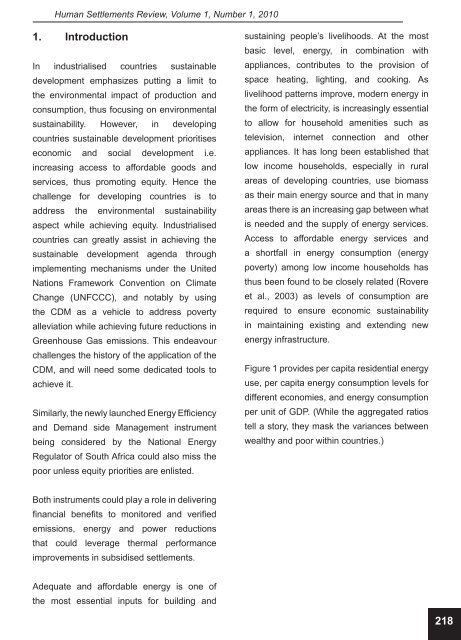Human Settlements Review - Parliamentary Monitoring Group
Human Settlements Review - Parliamentary Monitoring Group
Human Settlements Review - Parliamentary Monitoring Group
You also want an ePaper? Increase the reach of your titles
YUMPU automatically turns print PDFs into web optimized ePapers that Google loves.
<strong>Human</strong> <strong>Settlements</strong> <strong>Review</strong>, Volume 1, Number 1, 2010<br />
1. Introduction<br />
In industrialised countries sustainable<br />
development emphasizes putting a limit to<br />
the environmental impact of production and<br />
consumption, thus focusing on environmental<br />
sustainability. However, in developing<br />
countries sustainable development prioritises<br />
economic and social development i.e.<br />
increasing access to affordable goods and<br />
services, thus promoting equity. Hence the<br />
challenge for developing countries is to<br />
address the environmental sustainability<br />
aspect while achieving equity. Industrialised<br />
countries can greatly assist in achieving the<br />
sustainable development agenda through<br />
implementing mechanisms under the United<br />
Nations Framework Convention on Climate<br />
Change (UNFCCC), and notably by using<br />
the CDM as a vehicle to address poverty<br />
alleviation while achieving future reductions in<br />
Greenhouse Gas emissions. This endeavour<br />
challenges the history of the application of the<br />
CDM, and will need some dedicated tools to<br />
achieve it.<br />
Similarly, the newly launched Energy Efficiency<br />
and Demand side Management instrument<br />
being considered by the National Energy<br />
Regulator of South Africa could also miss the<br />
poor unless equity priorities are enlisted.<br />
sustaining people’s livelihoods. At the most<br />
basic level, energy, in combination with<br />
appliances, contributes to the provision of<br />
space heating, lighting, and cooking. As<br />
livelihood patterns improve, modern energy in<br />
the form of electricity, is increasingly essential<br />
to allow for household amenities such as<br />
television, internet connection and other<br />
appliances. It has long been established that<br />
low income households, especially in rural<br />
areas of developing countries, use biomass<br />
as their main energy source and that in many<br />
areas there is an increasing gap between what<br />
is needed and the supply of energy services.<br />
Access to affordable energy services and<br />
a shortfall in energy consumption (energy<br />
poverty) among low income households has<br />
thus been found to be closely related (Rovere<br />
et al., 2003) as levels of consumption are<br />
required to ensure economic sustainability<br />
in maintaining existing and extending new<br />
energy infrastructure.<br />
Figure 1 provides per capita residential energy<br />
use, per capita energy consumption levels for<br />
different economies, and energy consumption<br />
per unit of GDP. (While the aggregated ratios<br />
tell a story, they mask the variances between<br />
wealthy and poor within countries.)<br />
Both instruments could play a role in delivering<br />
financial benefits to monitored and verified<br />
emissions, energy and power reductions<br />
that could leverage thermal performance<br />
improvements in subsidised settlements.<br />
Adequate and affordable energy is one of<br />
the most essential inputs for building and<br />
218









![National Research Foundation Annual Report 2008 / 2009 [Part 2]](https://img.yumpu.com/49774036/1/177x260/national-research-foundation-annual-report-2008-2009-part-2.jpg?quality=85)







